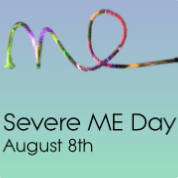Campaigning
Severe M.E Day – 8th of August 2019
A day to remember everyone who is suffering or who has ever suffered from Severe and Very Severe Myalgic Encephalomyelitis.

A day to honor
A day to honor the strength of spirit of all those who have endured and continue to endure decades of suffering and profound physical dysfunction and yet receive little, or no recognition or help, but rather continue to experience gross misrepresentation and misinterpretation of their illness and profound disability.
This Years Focus

Hanging On

By Chris Wilkinson
“The choices I make in life are simple –
Seek the beauty in everything
Seek the good in everyone
Never to surrender to self pity
For this year’s Severe ME Day Theme we decided to feature the very amazing and uplifting story of one of our member’s and her struggle against the odds to keep using her wonderful talent for art and photography. We are sure you will enjoy Christine’s Story.
I would like to invite you on a journey where hopefully, it will end with a smile.
I was fortunate on getting an invitation to join the 25% ME Group years ago when I lost my health to M E. It was on immediate diagnosis and the invitation was by my GP.
YOU became my family of understanding – a suture thread of connectedness. Lovely.
I learned I had Time To Stand And Stare, well, maybe not stand, ah? With meditation I could travel the world – climb Mt Everest – discover the rainforests of Brazil – visit the Taj Mahal…..
Then an obstacle – sight loss, but no. With what sight I had in my right eye I picked up my pencil
and …….
Illustrator who is triumphing over adversity
May 24 2006
Daily Post
A North Wales woman who triumphed over adversity to launch her own business said she is making every day count.
Prestatyn-based illustrator, Christine Wilkinson suffers from ME and deteriorating eyesight caused by a degenerative condition.
But she was determined not to let that stop her doing what she loves – drawing birds in their natural habitats across North Wales.
“I make a mental note of form, colour and texture when I see the birds in the field. When I get home I use that mental picture to sketch the birds using a magnifier,” she said.
“Now that my eyesight is dwindling by the day, I hope to draw a few more sketches before I will have to put my pencils away. Every sketch is drawn from the heart.”
Some of the pictures in coloured pencil can take Christine a week to complete – she is usually only able to work for 10 or 15 minutes at a time.
She retains her original artwork but hopes to sell prints of her drawings through her newly-started business Special Sightings.

Help us make a difference for severe M.E. sufferers
The 25% M.E. Group is a nationwide charity. We campaign to raise awareness of M.E and provide services to people affected by severe M.E. (Myalgic Encephalomyelitis). Your support is vital to our success. Join us to become a member, donate or get involved in our campaigning.
ME is a WHO classified neurological disease with multi-system dysfunction.
It is a physical disease that, in its more severe forms, is severely to profoundly disabling.
The most severely affected have multiple serious symptoms, often not investigated or under-investigated, that incapacitate people to such a degree that 25% of them are effectively house bound or bed bound, may use wheelchairs part or full- time and are barely able to move.
There is no cure. There is no consistent or universal treatment. The pain of Severe/Very Severe ME is so extreme that drugs do not touch it and many are forced to take extremely strong drugs to gain minimal reductions in pain levels. Others have no pain relief at all due to acute drug sensitivity.
There are a range of serious physical symptoms, with underlying neuro- immune and other physiological implications, which are highlighted further on.
Around 62,500 people suffer from severe ME in the UK. Severe ME is a serious, disabling chronic condition yet the healthcare these patients receive is ‘seriously inadequate!’
Quality of life tests indicate that severe ME sufferers feel every day significantly the same as an AIDS patient feels two months before death. 98% of people with severe ME do not get better. Peterson describes ME as “one of the most disabling diseases that I care for, far exceeding HIV disease except for the terminal stages”.
25% of sufferers with severe ME describe themselves as bedridden, and 57% have been either housebound or bedridden for more than six years, illustrating “in numbers rather than words that morbidity in ME can be substantial, despite the opinion of many healthcare professionals to the contrary.”
Researchers have demonstrated numerous abnormalities of the immune, muscular, cardiovascular, and central nervous systems. The emerging picture is of a multi-system disease with a strong component of immune and neurological dysfunction. The World Health Organisation recognises ME as a neurological illness.
ME describes an illness characterised by a combination of muscle pain (myalgia), and neurological and cognitive symptoms such as memory loss and concentration difficulties (hence ‘encephalomyelitis’). As with any illness, the symptoms and disability which results will be experienced differently by each individual. Symptoms can vary in severity and commonly include chronic pain and lack of stamina/weakness of the muscles and limbs, acute hypersensitivity to stimuli such as light and noise, cognitive and memory problems, vocal/muscular limitations, multi-joint pain, and severe migraine type headaches.
Severe ME
“Will be able to carry out minimal daily tasks only, face washing, cleaning teeth, have severe cognitive difficulties and be wheelchair dependent for mobility. These people are often unable to leave the house except on rare occasions with severe prolonged after-effect from effort.”
Very Severe ME
“Will be unable to mobilise or carry out any daily tasks for themselves and are in bed for the majority of the time. These people are often unable to tolerate any noise and are generally extremely sensitive to light.”
This means their physical and mental limitations are very acute. Commonly the person will require to use a wheelchair to get around, help with transferring from seat to seat within and out with the home, and may have problems with sitting up, using their arms and hands for even simple tasks like doing up buttons on clothing, and have difficulties toileting and bathing themselves. Some very severely affected patients are unable to do any of these tasks because of very severe pain and muscle weakness (not due to misuse or under use) and even transient paralysis – normally down left side. This can leave the person unable even to swallow, or to turn themselves in bed.
The prognosis for recovery from Myalgic Encephalomyelitis, after an illness endurance of 5 years or more is poor. The symptoms and level of severity can vary from person to person. There is always a danger of deterioration from over exertion or wrong treatment. A worsening of symptoms can often be unimaginable when suffering is already severe, however, greater deterioration is always a possibility, though not everyone continuously declines.
Those who get ME while still young, seem to have a stronger likelihood of some level of recovery, assuming that they get proper advice to rest and not over-exert themselves.
Tragically people die from ME or complications surrounding it. Merryn Croft, who died at 21 years of age is only the second person to formally be acknowledged to have died from Myalgic Encephalomyelitis, in the UK, Sophia Mirza, being the first.
Others sadly take their own lives, unable to tolerate the totality of their suffering
